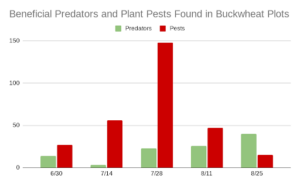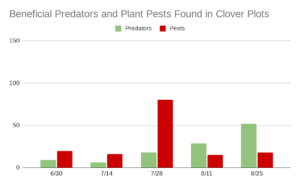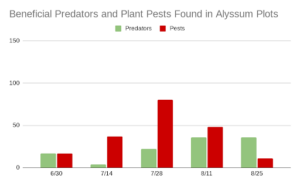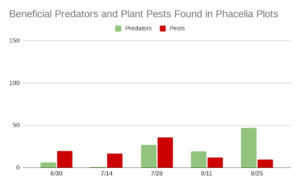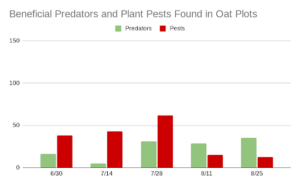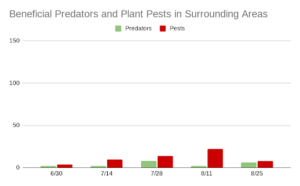Progress report for FW23-410
Project Information
The purpose of this project is to evaluate the efficacy of planting flowering cover crop plots to attract beneficial insect predators to nearby annual and perennial cut flower fields in Southcentral Alaska. Insect pests such as aphids, thrips, and tarnished plant bugs can damage important cut flower crops such as dahlias, stock, anemones and ranunculus. Controlling these pests using insecticides has the potential downsides of environmental and worker chemical exposure, equipment and labor costs, inconsistent and short-lived efficacy, and causing unintentional harm to populations of non-pest beneficial insects. We seek to provide growers with region-specific data about the efficacy of an alternative pest management tool: biological control. Specifically, we will be researching what types of flowering cover crops best attract beneficial insects that are predators to aphids, thrips, Lygus bugs, such as hover flies, big eyed bugs, damsel bugs, minute pirate bugs, wasps. While the use of cover crops, living mulches, and margin strips have been shown to be effective in attracting beneficial insect predators, many studies note the need for further research regarding how specific plant species, regionality, planting methods, or timing affects the efficacy of these practices. In order for these practices to be more widely adopted by growers in Alaska, they need to be demonstrated and proven locally.
Through an onsite demonstration day, agricultural conference presentation, and social media posts, the results of our project will give regional growers, agricultural professionals, and the general public information about the impact of including flowering cover crop plots on farms for the purposes of pest management.
Research Objective #1: Over two years of trials at Brown Dog Farm, determine the effect of four flowering cover crops–buckwheat, phacelia, red clover, alyssum–on attracting beneficial insect predators.
Research Objective #2: Over two years of trials at Brown Dog Farm, collect phenological data for four flowering cover crops in order to evaluate their suitability for incorporation on Southcentral Alaskan farms. Data collected will include germination date, flowering date, seed set and termination date, biomass production, and soil tests.
Education Objective #1: During years two and three of the funding period, provide at least 10 Alaskan flower and vegetable producers and agricultural service providers with reliable local data on the efficacy of using flowering cover crop plots to attract insect predators of major regional pests.
Education Objective #2: During years two and three of the funding period, provide at least 10 Alaskan flower and vegetable producers with reliable local data on technical aspects of utilizing flowering cover crop plots.
Education Objective #3: Throughout the funding period, share the potential benefits of using conservation biological control methods, including the use of flowering cover crop plots to attract beneficial insects, with local growers and the general public via social media.
The project timeline is described in the following Gantt Chart:
Cooperators
- - Technical Advisor
Research
Objective #1: Over two years of trials at Brown Dog Farm, determine the effect of four flowering cover crops–buckwheat, phacelia, red clover, alyssum–to attract beneficial insect predators.
This objective will be accomplished by planting subplots of each of the four cover crops for two consecutive years at Brown Dog Farm. Varieties adapted to short growing seasons will be selected. Year One cover crop plots were planted on 5/29/24, with two replicates of each of the four flowering cover crops planted along with non-flowering control subplots of oats, for a total of 10 subplots, divided between two larger plots. Each plot will totaled 120 x 45 ft., and each subplot will measured 24 ft. x 45 ft. The plots were located in two separate areas within Brown Dog Flower Farm's moose fence, each devoted to a two year cover crop fallow within the crop rotation plan. Each subplot was assigned a crop at random, and seeded at recommended rates using an Earthway broadcast seeder.
Insect sampling in cover crop plots began one month after seeding. On 6/26/24, 6 yellow sticky cards were placed at random locations within each subplot. Six control sticky cards were also placed in random locations of “spontaneous vegetation” surrounding the farm area, such as adjacent woodland and lawn areas. Sticky cards were left out for 4 days, then placed in bags in the freezer for data collection at a later point. A new set of sticky cards was placed in each subplot location at 2 week intervals until cover crop termination at the end of August. Additional sweep samples were taken in each subplot and two control locations (woodland and lawn) at two week intervals beginning 7/13/24. Contents of sweep samples will be deposited into a sealable bag, labeled, and frozen for later data collection.
Year 1 sticky cards and sweep samples were analyzed for presence of insect predators and common pests between 1/1/24 and 3/1/24 with the assistance of project technical advisor, Dennis Fielding. The above data collection process will be repeated during Year 2 of the project, after which data will be compiled, analyzed, and reported. Initial Year 1 findings are reported in the Results section below.
Objective #2: Over two years of trials at Brown Dog Farm, collect phenological data for four flowering cover crops in order to evaluate their suitability for incorporation on Southcentral Alaskan farms. Data collected will include germination date, flowering date, seed set and termination date, biomass production, and soil tests.
The cover crop plots described above were also monitored throughout the 2023 growing season for germination date, flowering date, seed set and termination, biomass production per square foot, and soil data. Soil samples were taken before planting and after crop termination in each subplot and sent to Brookside Laboratories for analysis of organic matter, pH, basic nutrients, and estimated available nitrogen (Test S001AN, Standard Soil with SMP/Sikora pH and Available N). Each subplot was observed weekly for the agronomic data listed in Objective #2, and key dates were recorded. Finally, before termination the above ground biomass produced by each cover crop subplot was be sampled by harvesting, drying, and weighing a 4 sq. ft. of cover crop selected at random.
Initial Year 1 agronomic and biomass results are displayed in a table below. This data will be compiled with Year 2 data and further analyzed, along with a combined analysis of soil sample results.
Objective #1
The following charts summarize the number of total pests found in each type of cover crop and control plot at five collection dates throughout the 2023 season. The most common insect predators found in cover crop plots were parasitic wasps and hover flies, and the most commonly found insect pests were aphids and leaf hoppers. Generally, insect predator quantities increased throughout the summer, while insect pest quantities increased until the 7/28/23 sampling and decreased after. Predator counts ranged from near zero to over 50, while pest counts ranged from near zero to near 150 (a significant outlying count on 7/28 in buckwheat plots).
All cover crop plots appeared to attract more predators and pests that collection sites placed in surrounding areas. Between plots, the pattern of predator presence seems fairly consistent no matter the species of cover crop planted. The total sum of predators found in each separate type of cover crop plot ranged between 100 (phacelia) and 116 (oats). The greater difference between plots appeared to be the number of pest insects found in each. In this category, the buckwheat, clover, and alyssum plots were much higher than the oat and phacelia lots, with the relative difference between pest and predator numbers being the most favorable in phacelia plots.
Most cover crop plots began flower around 7/20 (see data presented in Objective #2), after which insect predator numbers began to rise in all plots. One interesting line of inquiry may be examining whether this increase is due to seasonal ecological patterns in insect populations, or whether flowering cover crops made a difference for predator populations in certain areas. This pattern did not emerge as strongly in the surrounding area sample sites, which suggests that flowering cover crops could be at play in attracting insect predators (and pests). The seasonality question could be tested by achieving earlier cover crop flowering via transplanting or use of shorter season crops. Given the results presented here, attaining flower stage in cover crop plots earlier could be beneficial for attracting predators earlier in the season when high levels of pests are present.
A second year of data (2024) will allow us to more closely examine trends in predator attraction to flowering cover crops and to be able to make more precise recommendations to growers who are interested in this technique.
Objective #2
The following table and links describe agronomic data collected in each cover crop plot during the 2023 season. Plots showed remarkable uniformity in days to germination and to flower, except for clover, which germinated in 9 days instead of 7 and flowered in 69 days instead of 55. All plots were terminated at 89 days after planting, when flowers were beginning to turn to seed but no seed had matured to viability. Of the cover crops grown, buckwheat produced the greatest average biomass per acre (2494 lbs/acre), and clover produced the least (551 lbs/acre).
Major soil test levels remained relatively stable in all plots in terms of pH, organic matter, and most macro and micro nutrient levels. All plots saw a major increase in estimated releasable N between the Spring and Fall tests, however, no particular crop saw a significantly gain over another. No solid soil amendments or fertilizers were applied to cover crop plots at the beginning of the season. Plots were watered periodically with organic liquid nitrogen fertilizer (fish) in July.
The data presented here will be compiled with data collected during Year 2 of the project (2024) and further analyzed at the end of the season. In 2024, we plan to apply organic fertilizer (per AK Cooperative Extension recommendations) to the cover crop plots, which is likely to affect biomass production and soil nutrient levels. While fertilizing cover crop plots would not normally be part of our growing practices, we realized in Year 1 that the transition from previously raw land to farm field affected the growth of our cover crop plots; applying fertilizer will help us gain an understanding of how cover crops will produce in more favorable conditions.
Plot Key
Plot 1 = Crimson Clover
Plot 2 = Oats
Plot 3 = Buckwheat
Plot 4 = Phacelia
Plot 5 =Sweet Alyssum
Plot 6 = Buckwheat
Plot 7 = Sweet Alyssum
Plot 8 = Oats
Plot 9 = Clover
Plot 10 = Phacelia
Research Outcomes
This report shows data collected from Year 1 of 2 in our cover crop project. At the conclusion of our data analysis following Year 2, we hope to provide the following research outcomes:
- Information regarding which cover crops planted in this project have the potential to attract the beneficial insect predators compared to control plots and areas surrounding the farm (lawn and woods).
- Information about germination, flowering, and termination dates; biomass production, and soil health impacts of the cover crops planted in this project.
Education and Outreach
Participation Summary:
Education Objective #1: During years two and three of the funding period, provide at least 10 Alaskan flower and vegetable producers and agricultural service providers with reliable local data on the efficacy of using flowering cover crop plots to attract insect predators of major regional pests.
Work towards this objective will begin during Year 2 of the project.
Education Objective #2: During years two and three of the funding period, provide at least 10 Alaskan flower and vegetable producers with reliable local data on technical aspects of utilizing flowering cover crop plots.
Work towards this objective will begin during Year 2 of the project.
Education Objective #3: Throughout the funding period, share the potential benefits of using conservation biological control methods, including the use of flowering cover crop plots to attract beneficial insects, with local growers and the general public via social media.
Ongoing information about this project will be shared on our social media (Instagram) page. Each year, we will make four posts on topics directly related to the project on topics including project purpose, methods, potential benefits of cover cropping, identification of insect pests and predators, and potential benefits of conservation biological control methods. We expect at least 60 individuals to engage with each post, for a total of 720 engagements over 3 years.
During Year 1 we posted four project updates, these results of which are reported below.
Education Objective #3: Throughout the funding period, share the potential benefits of using conservation biological control methods, including the use of flowering cover crop plots to attract beneficial insects, with local growers and the general public via social media.
During Year 1 we posted project updates on the following dates and topics:
March 13, 2023: Project plans and overview, benefits of cover cropping and beneficial insects for flower growers. 123 Instagram engagements, 19 Facebook engagements.
August 14, 2023: Benefits of attracting insect predators to the farm with cover crops, species of garden pests we are hoping to thwart, pictures of flowering cover crop plots. 53 Instagram engagements, 9 Facebook engagements.
October 15, 2023: Benefits of including cover crop in farm plans, project overview, the use of cover crops to attract beneficial species. 53 Instagram engagements, 14 Facebook engagements.
January 27, 2024: The process of identifying beneficial and pest insects on sample sticky cards (with pictures). Names of most common predators found in our samples: parasitic wasps, hover flies, a damsel bug. 56 Instagram engagements, 10 Facebook engagements.
Education and Outreach Outcomes
Education and Outreach outcomes will be gained and shared after the Year 2 and 3 educational phases of this project.
